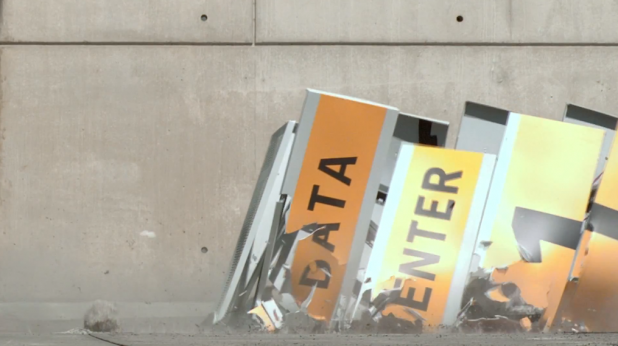 We're heard of servers crashing, but this is ridiculous.[/caption] What happens when you drop a server off of a building? It crashes. In the name of making a Hollywood-style advertisement, Symantec brought two identical servers to the top of San Jose’s City Hall—18 stories above the ground. Each rack represented a typical data center with a backup in a separate location, connected together via wireless. Then they tilted those servers off the roof. Each server rack was running multiple applications, including Oracle Database on Solaris and the application and presentation layer on Red Hat Enterprise Linux. The racks were clustered with the Veritas Cluster Server and replicated using Volume Replicator across the different backup sites. In a final touch, Symantec had the servers running a prototype health care application built to supply patient records to patients, hospital employees, and administrators. “In our real-life scenario, a lot of the times these are emergency room situations, these are doctors trying to access critical patient data, or patients trying to update that information,” Fahima Zahir, a technical specialist for Symantec, said in a behind-the-scenes video. If you don’t have a reliable data center solution, users could lose both the application and data if the server goes down. The server rack plunged to the ground, obliterating itself atop several steel plates pushed together to protect San Jose’s civic concrete. Data from the health care application had been synced to a single operator; as soon as he submitted the data, the server was pushed over the edge. Post-crash, the Veritas Operations Manager dashboard listed the server as “faulted,” then failed over to the backup. While it took several minutes to access the data, none of it was lost. “I heard a very large explosion which was datacenter 1, and it showed offline in the interface,” Brian Babineau, vice president of research and analyst services for analyst firm the Enterprise Strategy Group, said in the video. “The second system came right back up on line in about three or four minutes, and all of a sudden you could get the patient records from that second system.” Consumers who rely on Google or Microsoft’s cloud are used to saving even the tiniest changes to a document and having them instantly accessible in case the browser or the PC crashes. But in the enterprise, more magic needs to happen on the back end. Yes, the Symantec demonstration is a bit hokey (and an advertisement, to boot) and other solutions should be able to do the same thing. Still, it’s a graphic representation of how quickly an organization can lose its customer data—it doesn’t even take an 18-story drop, at least not most of the time. Some YouTube comments were as unkind to Symantec as the pavement was to the server. "I rather have seen Symantec Backup Exec fly off the roof and go boom, but this is close," a commenter named "Matthew LeBlanc" wrote. Added another: "If you want your datacenter to stay running, don't use Symantec products..." But others were more forgiving. "Anyone who thinks this wasn't real should watch the Behind the Scenes video," "drp328" wrote. "My brother works at Symantec,” wrote commenter drp328. “This was a real live server rack, and a real live fail-over demo. Unbelievable? Maybe. Legit? Absolutely." Image: Symantec
We're heard of servers crashing, but this is ridiculous.[/caption] What happens when you drop a server off of a building? It crashes. In the name of making a Hollywood-style advertisement, Symantec brought two identical servers to the top of San Jose’s City Hall—18 stories above the ground. Each rack represented a typical data center with a backup in a separate location, connected together via wireless. Then they tilted those servers off the roof. Each server rack was running multiple applications, including Oracle Database on Solaris and the application and presentation layer on Red Hat Enterprise Linux. The racks were clustered with the Veritas Cluster Server and replicated using Volume Replicator across the different backup sites. In a final touch, Symantec had the servers running a prototype health care application built to supply patient records to patients, hospital employees, and administrators. “In our real-life scenario, a lot of the times these are emergency room situations, these are doctors trying to access critical patient data, or patients trying to update that information,” Fahima Zahir, a technical specialist for Symantec, said in a behind-the-scenes video. If you don’t have a reliable data center solution, users could lose both the application and data if the server goes down. The server rack plunged to the ground, obliterating itself atop several steel plates pushed together to protect San Jose’s civic concrete. Data from the health care application had been synced to a single operator; as soon as he submitted the data, the server was pushed over the edge. Post-crash, the Veritas Operations Manager dashboard listed the server as “faulted,” then failed over to the backup. While it took several minutes to access the data, none of it was lost. “I heard a very large explosion which was datacenter 1, and it showed offline in the interface,” Brian Babineau, vice president of research and analyst services for analyst firm the Enterprise Strategy Group, said in the video. “The second system came right back up on line in about three or four minutes, and all of a sudden you could get the patient records from that second system.” Consumers who rely on Google or Microsoft’s cloud are used to saving even the tiniest changes to a document and having them instantly accessible in case the browser or the PC crashes. But in the enterprise, more magic needs to happen on the back end. Yes, the Symantec demonstration is a bit hokey (and an advertisement, to boot) and other solutions should be able to do the same thing. Still, it’s a graphic representation of how quickly an organization can lose its customer data—it doesn’t even take an 18-story drop, at least not most of the time. Some YouTube comments were as unkind to Symantec as the pavement was to the server. "I rather have seen Symantec Backup Exec fly off the roof and go boom, but this is close," a commenter named "Matthew LeBlanc" wrote. Added another: "If you want your datacenter to stay running, don't use Symantec products..." But others were more forgiving. "Anyone who thinks this wasn't real should watch the Behind the Scenes video," "drp328" wrote. "My brother works at Symantec,” wrote commenter drp328. “This was a real live server rack, and a real live fail-over demo. Unbelievable? Maybe. Legit? Absolutely." Image: Symantec Symantec Crashes Server—Off a Building
[caption id="attachment_5070" align="aligncenter" width="618"]  We're heard of servers crashing, but this is ridiculous.[/caption] What happens when you drop a server off of a building? It crashes. In the name of making a Hollywood-style advertisement, Symantec brought two identical servers to the top of San Jose’s City Hall—18 stories above the ground. Each rack represented a typical data center with a backup in a separate location, connected together via wireless. Then they tilted those servers off the roof. Each server rack was running multiple applications, including Oracle Database on Solaris and the application and presentation layer on Red Hat Enterprise Linux. The racks were clustered with the Veritas Cluster Server and replicated using Volume Replicator across the different backup sites. In a final touch, Symantec had the servers running a prototype health care application built to supply patient records to patients, hospital employees, and administrators. “In our real-life scenario, a lot of the times these are emergency room situations, these are doctors trying to access critical patient data, or patients trying to update that information,” Fahima Zahir, a technical specialist for Symantec, said in a behind-the-scenes video. If you don’t have a reliable data center solution, users could lose both the application and data if the server goes down. The server rack plunged to the ground, obliterating itself atop several steel plates pushed together to protect San Jose’s civic concrete. Data from the health care application had been synced to a single operator; as soon as he submitted the data, the server was pushed over the edge. Post-crash, the Veritas Operations Manager dashboard listed the server as “faulted,” then failed over to the backup. While it took several minutes to access the data, none of it was lost. “I heard a very large explosion which was datacenter 1, and it showed offline in the interface,” Brian Babineau, vice president of research and analyst services for analyst firm the Enterprise Strategy Group, said in the video. “The second system came right back up on line in about three or four minutes, and all of a sudden you could get the patient records from that second system.” Consumers who rely on Google or Microsoft’s cloud are used to saving even the tiniest changes to a document and having them instantly accessible in case the browser or the PC crashes. But in the enterprise, more magic needs to happen on the back end. Yes, the Symantec demonstration is a bit hokey (and an advertisement, to boot) and other solutions should be able to do the same thing. Still, it’s a graphic representation of how quickly an organization can lose its customer data—it doesn’t even take an 18-story drop, at least not most of the time. Some YouTube comments were as unkind to Symantec as the pavement was to the server. "I rather have seen Symantec Backup Exec fly off the roof and go boom, but this is close," a commenter named "Matthew LeBlanc" wrote. Added another: "If you want your datacenter to stay running, don't use Symantec products..." But others were more forgiving. "Anyone who thinks this wasn't real should watch the Behind the Scenes video," "drp328" wrote. "My brother works at Symantec,” wrote commenter drp328. “This was a real live server rack, and a real live fail-over demo. Unbelievable? Maybe. Legit? Absolutely." Image: Symantec
We're heard of servers crashing, but this is ridiculous.[/caption] What happens when you drop a server off of a building? It crashes. In the name of making a Hollywood-style advertisement, Symantec brought two identical servers to the top of San Jose’s City Hall—18 stories above the ground. Each rack represented a typical data center with a backup in a separate location, connected together via wireless. Then they tilted those servers off the roof. Each server rack was running multiple applications, including Oracle Database on Solaris and the application and presentation layer on Red Hat Enterprise Linux. The racks were clustered with the Veritas Cluster Server and replicated using Volume Replicator across the different backup sites. In a final touch, Symantec had the servers running a prototype health care application built to supply patient records to patients, hospital employees, and administrators. “In our real-life scenario, a lot of the times these are emergency room situations, these are doctors trying to access critical patient data, or patients trying to update that information,” Fahima Zahir, a technical specialist for Symantec, said in a behind-the-scenes video. If you don’t have a reliable data center solution, users could lose both the application and data if the server goes down. The server rack plunged to the ground, obliterating itself atop several steel plates pushed together to protect San Jose’s civic concrete. Data from the health care application had been synced to a single operator; as soon as he submitted the data, the server was pushed over the edge. Post-crash, the Veritas Operations Manager dashboard listed the server as “faulted,” then failed over to the backup. While it took several minutes to access the data, none of it was lost. “I heard a very large explosion which was datacenter 1, and it showed offline in the interface,” Brian Babineau, vice president of research and analyst services for analyst firm the Enterprise Strategy Group, said in the video. “The second system came right back up on line in about three or four minutes, and all of a sudden you could get the patient records from that second system.” Consumers who rely on Google or Microsoft’s cloud are used to saving even the tiniest changes to a document and having them instantly accessible in case the browser or the PC crashes. But in the enterprise, more magic needs to happen on the back end. Yes, the Symantec demonstration is a bit hokey (and an advertisement, to boot) and other solutions should be able to do the same thing. Still, it’s a graphic representation of how quickly an organization can lose its customer data—it doesn’t even take an 18-story drop, at least not most of the time. Some YouTube comments were as unkind to Symantec as the pavement was to the server. "I rather have seen Symantec Backup Exec fly off the roof and go boom, but this is close," a commenter named "Matthew LeBlanc" wrote. Added another: "If you want your datacenter to stay running, don't use Symantec products..." But others were more forgiving. "Anyone who thinks this wasn't real should watch the Behind the Scenes video," "drp328" wrote. "My brother works at Symantec,” wrote commenter drp328. “This was a real live server rack, and a real live fail-over demo. Unbelievable? Maybe. Legit? Absolutely." Image: Symantec
 We're heard of servers crashing, but this is ridiculous.[/caption] What happens when you drop a server off of a building? It crashes. In the name of making a Hollywood-style advertisement, Symantec brought two identical servers to the top of San Jose’s City Hall—18 stories above the ground. Each rack represented a typical data center with a backup in a separate location, connected together via wireless. Then they tilted those servers off the roof. Each server rack was running multiple applications, including Oracle Database on Solaris and the application and presentation layer on Red Hat Enterprise Linux. The racks were clustered with the Veritas Cluster Server and replicated using Volume Replicator across the different backup sites. In a final touch, Symantec had the servers running a prototype health care application built to supply patient records to patients, hospital employees, and administrators. “In our real-life scenario, a lot of the times these are emergency room situations, these are doctors trying to access critical patient data, or patients trying to update that information,” Fahima Zahir, a technical specialist for Symantec, said in a behind-the-scenes video. If you don’t have a reliable data center solution, users could lose both the application and data if the server goes down. The server rack plunged to the ground, obliterating itself atop several steel plates pushed together to protect San Jose’s civic concrete. Data from the health care application had been synced to a single operator; as soon as he submitted the data, the server was pushed over the edge. Post-crash, the Veritas Operations Manager dashboard listed the server as “faulted,” then failed over to the backup. While it took several minutes to access the data, none of it was lost. “I heard a very large explosion which was datacenter 1, and it showed offline in the interface,” Brian Babineau, vice president of research and analyst services for analyst firm the Enterprise Strategy Group, said in the video. “The second system came right back up on line in about three or four minutes, and all of a sudden you could get the patient records from that second system.” Consumers who rely on Google or Microsoft’s cloud are used to saving even the tiniest changes to a document and having them instantly accessible in case the browser or the PC crashes. But in the enterprise, more magic needs to happen on the back end. Yes, the Symantec demonstration is a bit hokey (and an advertisement, to boot) and other solutions should be able to do the same thing. Still, it’s a graphic representation of how quickly an organization can lose its customer data—it doesn’t even take an 18-story drop, at least not most of the time. Some YouTube comments were as unkind to Symantec as the pavement was to the server. "I rather have seen Symantec Backup Exec fly off the roof and go boom, but this is close," a commenter named "Matthew LeBlanc" wrote. Added another: "If you want your datacenter to stay running, don't use Symantec products..." But others were more forgiving. "Anyone who thinks this wasn't real should watch the Behind the Scenes video," "drp328" wrote. "My brother works at Symantec,” wrote commenter drp328. “This was a real live server rack, and a real live fail-over demo. Unbelievable? Maybe. Legit? Absolutely." Image: Symantec
We're heard of servers crashing, but this is ridiculous.[/caption] What happens when you drop a server off of a building? It crashes. In the name of making a Hollywood-style advertisement, Symantec brought two identical servers to the top of San Jose’s City Hall—18 stories above the ground. Each rack represented a typical data center with a backup in a separate location, connected together via wireless. Then they tilted those servers off the roof. Each server rack was running multiple applications, including Oracle Database on Solaris and the application and presentation layer on Red Hat Enterprise Linux. The racks were clustered with the Veritas Cluster Server and replicated using Volume Replicator across the different backup sites. In a final touch, Symantec had the servers running a prototype health care application built to supply patient records to patients, hospital employees, and administrators. “In our real-life scenario, a lot of the times these are emergency room situations, these are doctors trying to access critical patient data, or patients trying to update that information,” Fahima Zahir, a technical specialist for Symantec, said in a behind-the-scenes video. If you don’t have a reliable data center solution, users could lose both the application and data if the server goes down. The server rack plunged to the ground, obliterating itself atop several steel plates pushed together to protect San Jose’s civic concrete. Data from the health care application had been synced to a single operator; as soon as he submitted the data, the server was pushed over the edge. Post-crash, the Veritas Operations Manager dashboard listed the server as “faulted,” then failed over to the backup. While it took several minutes to access the data, none of it was lost. “I heard a very large explosion which was datacenter 1, and it showed offline in the interface,” Brian Babineau, vice president of research and analyst services for analyst firm the Enterprise Strategy Group, said in the video. “The second system came right back up on line in about three or four minutes, and all of a sudden you could get the patient records from that second system.” Consumers who rely on Google or Microsoft’s cloud are used to saving even the tiniest changes to a document and having them instantly accessible in case the browser or the PC crashes. But in the enterprise, more magic needs to happen on the back end. Yes, the Symantec demonstration is a bit hokey (and an advertisement, to boot) and other solutions should be able to do the same thing. Still, it’s a graphic representation of how quickly an organization can lose its customer data—it doesn’t even take an 18-story drop, at least not most of the time. Some YouTube comments were as unkind to Symantec as the pavement was to the server. "I rather have seen Symantec Backup Exec fly off the roof and go boom, but this is close," a commenter named "Matthew LeBlanc" wrote. Added another: "If you want your datacenter to stay running, don't use Symantec products..." But others were more forgiving. "Anyone who thinks this wasn't real should watch the Behind the Scenes video," "drp328" wrote. "My brother works at Symantec,” wrote commenter drp328. “This was a real live server rack, and a real live fail-over demo. Unbelievable? Maybe. Legit? Absolutely." Image: Symantec 

